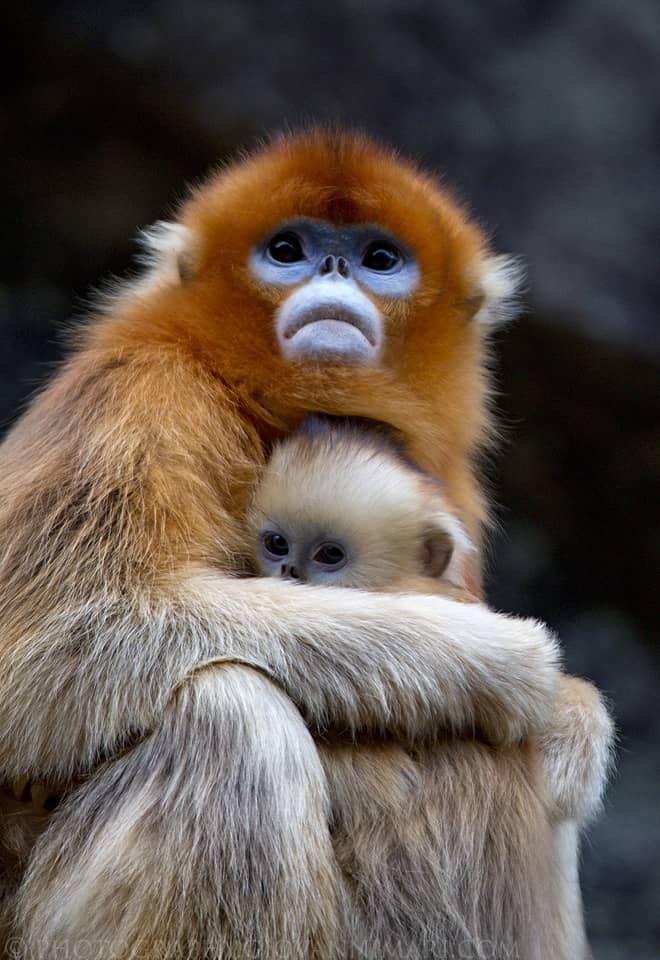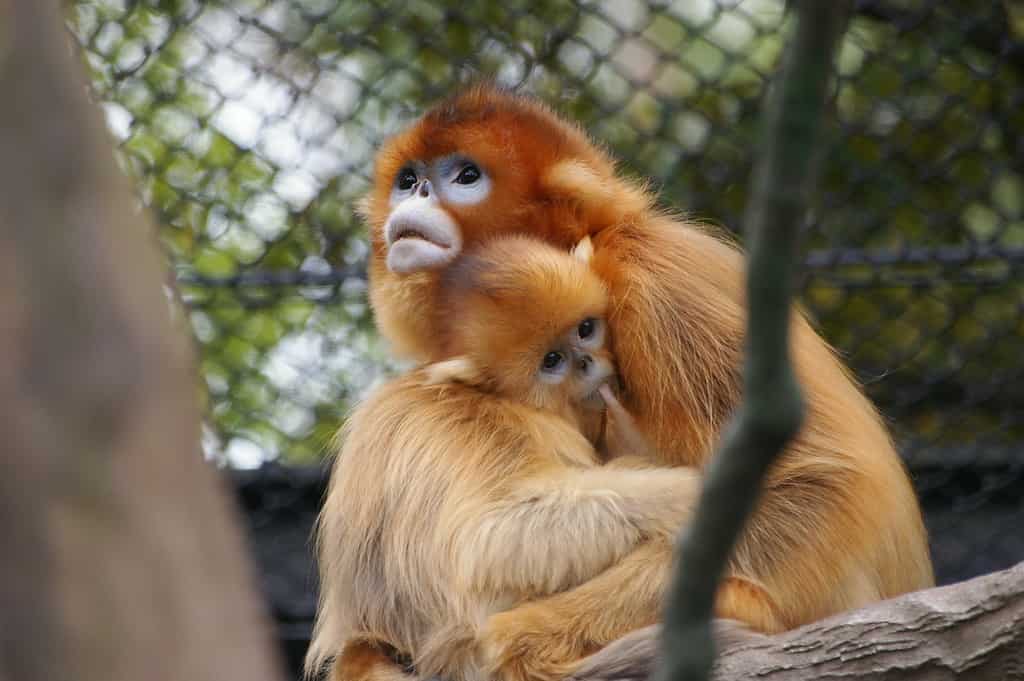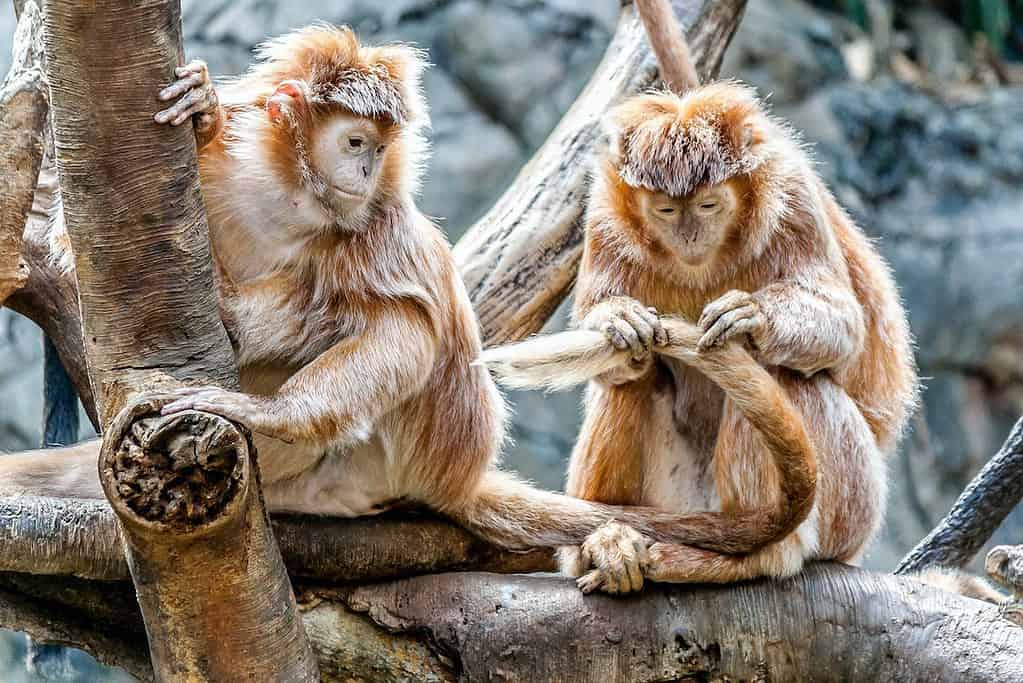
The golden snub-nosed monkey is one of the most Imagine you’re on a hike through the misty, mountainous forests of Central China. You hear a sudden rustle in the trees above you. Look up, and you might just spot a flash of gold darting through the canopy. You’ve just had a rare encounter with the golden snub-nosed monkey—a creature as enigmatic as it is endangered.
The golden snub-nosed monkey has a fur coat that’s an arresting blend of golden, white, and blueish-grey. This magnificent coat enables it to tolerate snow better than any other primate. And let’s not forget its most memorable feature: a nose that’s more of a nub, flattened against its face.
Extremely complex social structure
The complex society of snub-nosed monkeys—specifically the golden snub-nosed monkey—is a subject of fascination for primatologists and wildlife enthusiasts alike. These monkeys live in intricate social hierarchies complete with alliances, rivalries, and dramatic shifts in power. But let’s take it step by step.
Let’s begin with the basic organization. Golden snub-nosed monkeys live in multilevel societies. At the most basic level, you have the “one-male unit” (OMU), which comprises a single adult male, multiple adult females, and their offspring. Multiple OMUs can come together to form a band, and several bands make up a troop.
Troops also have an interesting and fluid social setup. Known as a fission-fusion social clump, larger groups (populations, or troops) break off into smaller groups depending on the temporal and spatial conditions of their environment.

For instance, golden snub-nosed monkeys have multiple levels of organization. At the most basic level, these monkeys aggregate in herds or clans consisting of a singular breeding male, his harem of breeding females, and any associated juveniles and infants.
However, multiple male social levels have also been documented. Bachelor males, mostly those who are yet to breach the cusp of adulthood (read: juveniles and subadults), forage and shelter together. Most often these “bro groups” are very literally fraternal units that are formed when the associated male offspring (brothers, half brothers) from a fundamental level aggregation age out of their familial herd. Sometimes, an infant may grow up and instead usurp dominance from the resident or dominant male directly, thus taking the reins of the fundamental aggregation or herd that he was born into.
Female monkeys also have their hierarchies within the OMU, often determined by factors like age, experience, and sometimes lineage. The older or more experienced females typically enjoy better access to resources like food and grooming from their male counterpart. Even the task of caring for the young is influenced by these hierarchies, with higher-ranking females sometimes receiving more help in childcare from lower-ranking ones.
There’s also evidence to suggest that certain behaviors and preferences may be learned rather than instinctual, indicating a rudimentary form of culture within these monkey societies. For instance, different troops have been observed using unique techniques to access food or avoid predators.
An Old-World Monkey Struggling in a New World
But despite its remarkable adaptations, the golden snub-nosed monkey isn’t doing all that well. Like many Old-World Monkeys, it’s struggling.
“Old World monkeys” is a term used to describe a specific group of primates that belong to the family Cercopithecidae. These monkeys are native to Africa and Asia, and they differ from their New World monkey counterparts, which are found in Central and South America.
| Old World Monkeys | New World Monkeys |
| Native to Africa and Asia | Native to South America |
| Lack prehensile tails | Possess prehensile tails |
| Generally larger | Generally smaller |
| Have cheek pouches | Lack cheek pouches |
Old World monkeys are versatile creatures, inhabiting a range of environments from grasslands to forests to mountainous regions. You’ll find baboons gallivanting across the savannas of Africa and macaques mingling near temples in Asia. Their adaptability is remarkable and speaks volumes about their evolutionary success. For instance, golden snub-nosed monkeys are excellently adjusted to the tough environments of Tibet, which we’ll get to in a moment.

What sets Old World monkeys apart? For starters, their noses are generally more downward-facing, and they often have smaller, less flexible tails than New World monkeys. Some don’t have tails at all. You’ll also notice that Old World monkeys usually have larger bodies and bigger brains in proportion to their size. But it’s not all good for these creatures, and it’s not all good for the snub-nosed monkey.
The Golden Snub-Nosed Monkey is Found only in the incredibly fragmented temperate montane forests of the Tibetan Plateau, and this old-world monkey may be losing its place in the new world.
The Monkey who likes the cold
The golden snub-nosed monkey found its environmental niche in the cold.
Also known as Sichuan Golden Monkeys, these animals boast an ancient lineage. As proud members of the Cercopithecidae family, they carry an old genetic heritage.
There are actually three subspecies of this monkey, and they all have a long-standing connection with humans in their habitats.
For local communities, the golden snub-nosed monkey holds a special place in folklore and tradition. They’re seen as guardians of the forest, and their presence is thought to bring good luck. In a way, they are symbolic of the delicate balance between humans and nature, a relationship that has grown increasingly strained over time.
This is where things take a darker turn. As captivating as they are, golden snub-nosed monkeys are critically endangered. Habitat loss and hunting have decimated their numbers. Just a few decades ago, you could find troops of these monkeys roaming freely. Now, only fragmented communities remain, confined to reserves and constantly at risk.

Endemic to China, these primates can be found in only four provinces, Sichuan, Gansu, Shaanxi, and Hubei in the central and southwestern parts of the country. Within these provinces as well, their presence is far from widespread.
These remarkable specialists are limited to elevations ranging from 1,500 to 3,400 meters above sea level and exclusively inhabit forests characterized by either deciduous, mixed coniferous, or broadleaf vegetation. They can only survive in these areas, and these areas are continuously exploited and fragmented by humans.

Conservation status and threats
Golden snub-nosed monkeys are “specialists” — they like environments for which they’re well adapted to. They’re picky with their coniferous and broadleaf habitats. They reside in broadleaf habitats only at elevations above 2,200 m and in mixed coniferous forests at altitudes above 2,600 m
Still, they’re not that picky. They’ve been observed in deciduous forests, mixed-leaf forests, and even high-altitude coniferous forests. They have a diet that consists of leaves, fruits, seeds, and occasionally small animals, showing a certain level of dietary flexibility.
It’s essential to note that while the golden snub-nosed monkeys are specialized in some aspects—like their social structure and vocalizations—the key factors contributing to their endangered status are overwhelmingly related to human impact rather than their biological specialization. They are capable of surviving and even thriving in their natural habitats if left undisturbed.
This specialization explains, in part, why they’re endangered. Per the IUCN Red List, The Golden Snub-Nosed Monkey is endangered. In fact, every subspecies of the Golden Snub-Nosed Monkey as well as every species of the genera of Snub-Nosed Monkey is endangered.
The primary threats facing golden snub-nosed monkeys are habitat loss and fragmentation, often due to human activities like logging, agricultural expansion, and infrastructure development. These activities reduce the size of the monkey’s living space and separate populations, making it more difficult for them to find food, shelter, and mates.
Another significant threat is illegal hunting. Their striking appearance, particularly their golden fur, makes them targets for the wildlife trade, both for their body parts and sometimes as exotic pets.
But their immediate concern has more to do with habitat loss now. Their range is quite small and they need dense swathes of canopied landscapes in one stretch.
But In spite of their endangered nature, currently, no specific species recovery plans or site recovery plans have been enacted.
Understudied, underappreciated
Predictably, these primates do not adhere to fixed home ranges but rather move seasonally among their diverse range of habitats. But they’re very difficult to study.
The group in itself isn’t adequately researched. These monkeys exhibit a preference for higher elevations, thriving at altitudes exceeding 4,000 meters (13,000 ft). Adding to the challenge for researchers, they not only contend with high altitudes but also grapple with the monkeys’ seasonal movements. During the winters, these primates alter their home ranges, venturing deeper into more remote and unfragmented expanses of forest to weather the cold months.
Researchers are working hard to understand how to best try to save these creatures. They use drone technology to monitor populations and employ satellite tracking to understand migration patterns. The more we know about their lives, the better equipped we’ll be to protect them. As researchers dig deeper, they’re uncovering surprising facts. Did you know that these monkeys have different vocalizations for different types of predators? Such discoveries aren’t just fascinating—they’re vital for conservation efforts.
As of now, the genus comprises just five recognized species:
- Golden Snub-Nosed Monkey
- Black-and-White Snub-Nosed Monkey
- Gray Snub-Nosed Monkey
- Tonkin Snub-Nosed Monkey
- Myanmar or Black Snub-Nosed Monkey
However, there are many details we still don’t know about these fascinating monkeys.
Appearance
With an average length of approximately 68.0 cm (26.8 in) for males and 51.8 cm (20.4 in) for females, these monkeys are the size of a standard backpack.
While both genders rock the distinctive namesake hues of gold on their bellies, foreheads, and necks, they still exhibit noticeable differences. Male golden snub-nosed monkeys don a contrasting dark grayish-black coat on the nape of their necks, extending from their shoulders down to their arms, as well as on their heads and tails. In contrast, females display these same areas adorned with a brownish hue.
On the contrary, infants and juveniles have brown or gray fur. As they progress through their development, juveniles gradually acquire a reddish coat, which further transforms into the characteristic hues of gold that don sub-adults and ultimately adults who have acquired full maturity.
| Age (Years) | Stage of Life |
| 0-1 | Infant |
| 1-3 | Juvenile |
| 3-5/ 3-4 | Sub-Adult Male, Sub-Adult Female |
| 5+/4+ | Adult Male/ Adult Female |
Taxonomy
Biologists have further classified the species into three different sub-species based on the lengths of their tails as well as a few skeletal differences:
- Moupin Golden-Snub Nosed Monkey: The OG Sichuan snub-nosed monkey, sizable populations, of the sub-species exclusively thrive in the high elevations of the Qionglai, Min, Daxiangling, and Xiaoxiangling Mountains that abut the Sichuan Basin.
- Qinling Golden-Snub Nosed Monkey: Sequestered in the Qinling Mountains in the Shaanxi province, around 4000 individuals of this sub-species reside in 39 troops.
- Hubei Golden-Snub Nosed Monkey: The smallest population of all three subspecies, there are only approximately 1,100 subspecies (5-6 troops) of the Hubei Golden-Snub Nosed Monkeys isolated in the Daba mountains of China.
These three subspecies not only exhibit differences in physical characteristics but are also geographically distinct from each other
Golden Snub-Nosed Monkey Facts
The Golden Snub-Nosed Monkey isn’t the only endangered species up in the hills of China; their range overlaps with Giant Pandas in Sichuan, Shaanxi, and Gansu! This spatial overlap in range bodes well for both species as sympatric conservation plans to preserve them can be devised.
These monkeys love a good dead tree to munch on as their primary source of nutrition, lichen, is significantly more abundant on dead trees than on live ones. Notably, this affinity for the dead is also what contributes to the limited range of these animals as dead trees are harvested from their habitats as firewood or driftwood.
The nomenclature of these monkeys offers a fun segue into Ottoman history. The specific epithet of the golden snub-nosed monkeys, “roxellana,” is a nod to Süleyman the Magnificent’s consort, the original namesake!
Caption: Süleyman the Magnificent was the influential sultan of the Ottoman Empire known for the transformation of Constantinople into Istanbul.
Attribution: https://commons.wikimedia.org/wiki/File:Papio_anubis_(Serengeti,_2009).jpg
Recent Studies on golden snub-nosed monkeys
In June 2023, scientists from a group of universities ( Northwest University in China, University of Bristol in UK, and the University of Western Australia in Australia) surmised for the first time ever that odd-nosed monkeys (like the golden-snub-nosed monkey) developed distinct and peculiar social organizations as a long-term adaptation in response to their extremely cold habitats.
The fascinating study revealed that colobines, a subfamily of the Old World monkeys, lived in colder climates developed hormonal pathways that increased dopamine and oxytocin production thus boosting maternal care in these primates. This meant that mother primates would breastfeed their little ones longer than non-colobine primates and extend care for longer periods as well. All of this contributed to long term adaptive change that enabled strengthened relationships between individuals in troops!
“Our study identified, for the first time, a genetically regulated adaptation linked to the evolution of social systems in primates,” opined Dr. Kit Opie, a researcher from the University of Bristol opined in a news release dated July 1st, 2023.
In the same release, Dr. Cyril Grueter explained that the study provided a unique perspective on the role of climate in social evolution.
“With climate change becoming an hugely important environmental pressure on animals, it is hoped that this study will raise awareness for the need to investigate what course social evolution will take as the prevailing climate changes,” said Dr. Grueter.
Golden snub-nosed monkey videos and GIFS
A special creature worthy of our attention
The golden snub-nosed monkey, with its peculiar name and even more peculiar morphological and social adaptations, provides a captivating window into the new world of old world primates. Their unique ecological roles, social structures, and adaptations to cold provide a unique perspective on the multifaceted nature of animal evolution. However, with habitat loss and fragmentation encroaching upon their dwindling habitats, the golden snub-nosed monkey’s future hangs in the balance.
As the pages turn in our quest to know more about these beguiling primates, it’s evident that the clock is ticking for the golden snub-nosed monkeys. The fragments of knowledge we’ve gathered only emphasize how much more we have yet to learn. These complex, social creatures, with their rich hierarchies and unique adaptations to some of China’s harshest climates, offer us a glimpse into a world that’s rapidly disappearing under the weight of human encroachment.
But the story doesn’t have to end here, and it shouldn’t. Not when we know that targeted conservation efforts can make a difference. The same drone technology and satellite tracking that have expanded our understanding can help us create conservation strategies that are not only effective but also respectful of the monkey’s natural behavior and habitat requirements. Additionally, their overlapping habitats with other endangered species like the Giant Panda offer the opportunity for multi-species conservation plans, making every dollar invested work twice as hard.
In local folklore, the golden snub-nosed monkey is a guardian of the forest, a symbol of good fortune and the fragile equilibrium between humans and nature. Perhaps it’s time to return the favor. Ensuring the survival of these golden guardians isn’t just about saving another species from extinction; it’s about acknowledging the intricate web of life to which we all belong. By investing in their future, we’re safeguarding our own. The next time you hear a rustle in the treetops, may it herald not just the presence of this rare creature, but also a renewed commitment to the extraordinary biodiversity of our planet.






